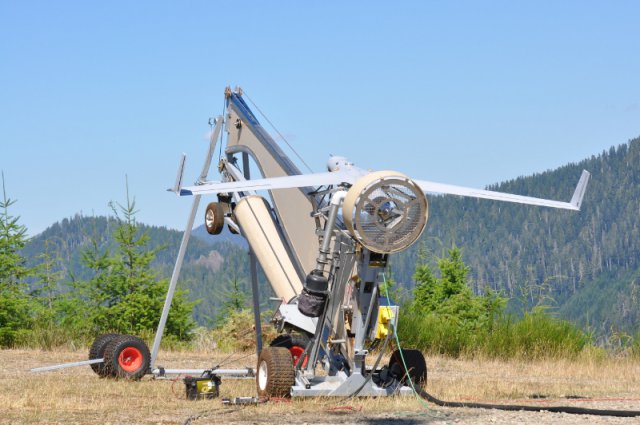While more than 625,000 acres of wildfires burned throughout the Pacific Northwest, crew members of the Insitu Rapid Response team launched a ScanEagle unmanned aircraft into the hazy skies above the Paradise Fire in Washington’s Olympic National Park. The event marked the beginning of an operational demonstration designed to show how unmanned aircraft technology can be a powerful force multiplier in the fight against wildfires.
ScanEagle flew six operations, delivering more than 37 hours of infrared video in real time to Incident Command personnel. Insitu’s suite of motion imagery software provided enhanced video and geo-registration capabilities that enabled fire officials to pinpoint the fire’s perimeter and identify areas of intense heat. ScanEagle also assisted helicopter assets with evaluating water drop locations.
“This and other planned unmanned aircraft systems demonstrations will serve to guide our policies, procedures and requirements for the safe, phased integration of UAS in support of wildfire management,” said Mark Bathrick, Director, Department of the Interior, Office of Aviation Services. “These demonstrations are part of a larger interagency strategy aimed at employing UAS to provide firefighters on the ground with time-sensitive information that will give them the highest level of situational awareness and support possible.”
“We are honored to support the individuals who are risking their lives to protect the natural resources endangered by wildfires in the Pacific Northwest,” said Insitu President and CEO Ryan M. Hartman. “This exercise demonstrated our ability to collect, process and deliver information that helps fire officials achieve better outcomes.”
ScanEagle flew within an emergency certificate of authorization (ECOA) issued to the Department of Interior from the FAA that permitted its operation within the confines of the temporary flight restriction.
“We have to determine how we’ll safely integrate these things into our existing tactical aircraft fire traffic area,” said Brad Koeckeritz, Interior’s national unmanned aircraft specialist. “By next year, we’ll see increased usage. It’ll be consistent growth of these (unmanned) aircraft as time goes on.”
Koeckeritz said the ScanEagle test over the Paradise fire in the Olympic National Park was “highly successful.”
Fire managers “were able to see through the smoke very clearly. They were able to determine the intensity of the fire and clearly see the fire’s edge,” Koeckeritz said.
In addition to using drones on surveillance missions, Koeckeritz said that in Boise, Idaho, this October, Interior will also test an “optionally manned” helicopter for delivering supplies and water to firefighters.
Such a vehicle could be piloted on clear days but sent up unmanned at times when manned helicopters cannot fly, either at night or when smoke reduces visibility.
With fires burning throughout Washington state and across the western U.S., manned aircraft, both helicopters and fixed wing planes, are spread thin.
The 2,800-acre Paradise fire was detected in mid-June. The statewide drought has affected even the Olympic Peninsula rainforest, where Reid said the snowpack on the mountains is 14 percent of normal and melted off four months earlier than usual.
In the area of the wildfire, large dead trees are dried out and provide heavy fuel for the blaze. It’s also burning as much as 6 inches deep into the forest duff _ a thick matt on the forest floor composed of years of dead leaves and other organic material.
Unlike live trees which may burn only superficially as a fire passes through, such deep fuel, said Reid, “will burn and burn and burn.”
Because of the high fuel load and steep canyons in the area, it’s too dangerous to try to attack the interior of the fire. The strategy then is to let it burn clean in the interior and confine it on the edges.
About 30 firefighters on the ground and two helicopter crews have been deployed to create containment lines to prevent the fire spreading west.
All were pulled out Friday as rain came in, because manned aircraft wouldn’t be able to fly and assist in case of an emergency.
The fire-fighting airplanes in use now in eastern Washington cost millions of dollars and are mostly provided to the government by private contractors at a cost of $27,000 per day, plus $10,000 per hour of flying.
Buying a ScanEagle system costs much less than a manned aircraft. Koeckeritz said the government will likely set up a similar private contracting system for fire-fighting drones.
Unmanned and relatively cheap, drones present a much lower risk if anything goes wrong.
As a result, said Reid, the National Park Service is considering using drones for other missions, including search and rescue operations.
Source: Herald & Tribune, Press Release

